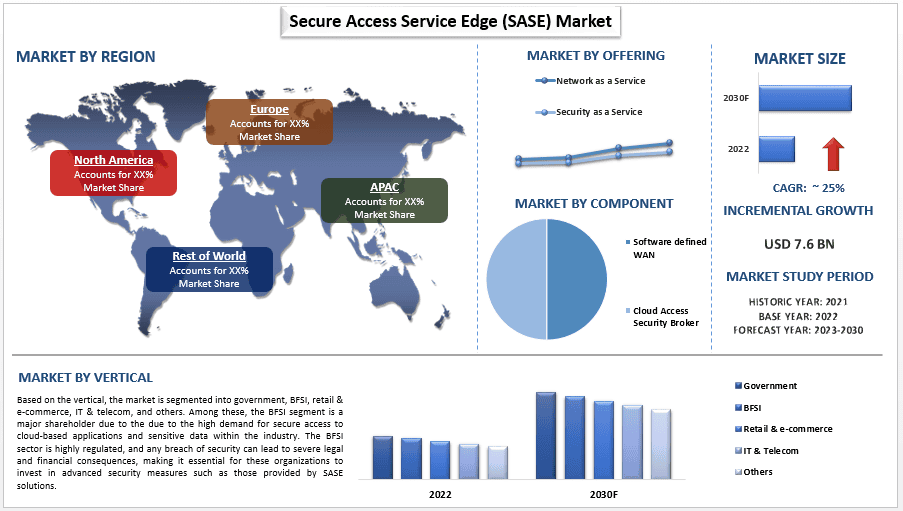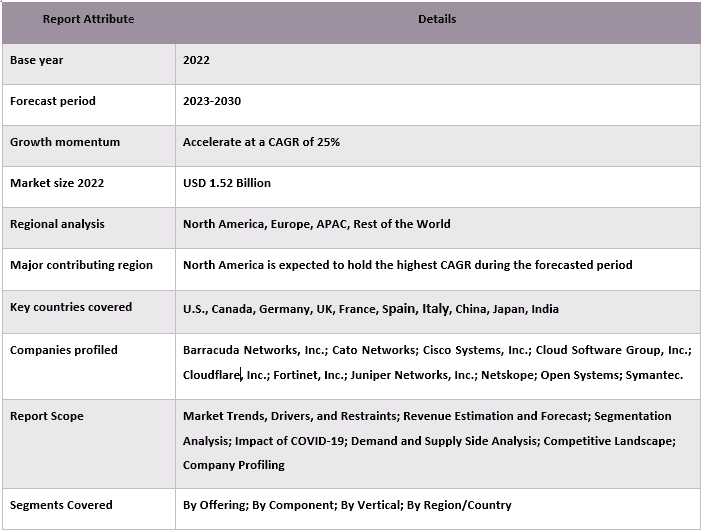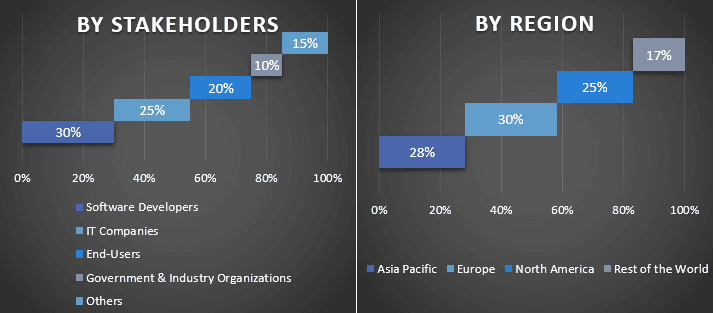- Accueil
- À propos de nous
- Industrie
- Services
- Lecture
- Contactez-nous
Marché Secure Access Service Edge (SASE) : Analyse actuelle et prévisions (2023-2030)
Accent mis sur l'offre (Network As A Service et Security As A Service) ; Composant (Software Defined WAN et Cloud Access Security Broker) ; Verticale (Gouvernement, BFSI, Commerce de détail et commerce électronique, IT & Telecom, et autres) et Région/Pays.

Marché Secure Access Service Edge (SASE) – Scénario actuel et prévisions (2023-2030)
Le marché Secure Access Service Edge (SASE) était évalué à 1,52 milliard de dollars en 2022 et devrait croître à un rythme régulier d'environ 25 % au cours de la période de prévision (2023-2030) en raison de sa capacité à fournir des fonctionnalités de sécurité complètes sans sacrifier les performances ni la convivialité. Secure Access Service Edge (SASE) est une technologie relativement nouvelle qui combine des capacités de passerelle Web sécurisée avec un accès au réseau d'entreprise. Il offre un accès sécurisé aux services et applications cloud tout en protégeant contre les cybermenaces. De plus, des facteurs tels que l'adoption croissante d'applications basées sur le cloud, la sensibilisation croissante aux risques de sécurité et les progrès technologiques, l'intelligence artificielle (IA), l'apprentissage automatique (ML) et l'automatisation contribuent à l'adoption croissante des solutions SASE, stimulant la croissance prévue du marché.
Certains des principaux acteurs opérant sur le marché comprennent Barracuda Networks, Inc. ; Cato Networks ; Cisco Systems, Inc. ; Cloud Software Group, Inc. ; Cloudflare, Inc. ; Fortinet, Inc. ; Juniper Networks, Inc. ; Netskope ; Systèmes Ouverts ; Symantec.
Informations présentées dans le rapport
« Parmi les offres, le segment de la sécurité en tant que service détient une part de marché importante au cours de la période de prévision. »
Sur la base de l'offre, le marché est divisé en réseau en tant que service et sécurité en tant que service. Parmi ceux-ci, le segment de la sécurité en tant que service détient une part de marché importante en raison du besoin croissant de mesures de sécurité robustes pour se protéger contre les cybermenaces, en particulier parmi les petites et moyennes entreprises (PME).
« Parmi les secteurs verticaux, le segment BFSI détient la part la plus importante au cours de la période de prévision. »
Basé sur le secteur vertical, le marché est segmenté en gouvernement, BFSI, vente au détail et commerce électronique, informatique et télécommunications, et autres. Parmi ceux-ci, le segment BFSI est un actionnaire important en raison de la forte demande d'accès sécurisé aux applications basées sur le cloud et aux données sensibles au sein du secteur. Le secteur BFSI est fortement réglementé, et toute violation de la sécurité peut entraîner de graves conséquences juridiques et financières, ce qui rend essentiel pour ces organisations d'investir dans des mesures de sécurité avancées telles que celles fournies par les solutions SASE.
« L'Amérique du Nord détiendra une part importante du marché. »
L'Amérique du Nord domine le marché en raison de l'adoption précoce de l'informatique en nuage et des tendances du travail à distance dans la région, créant une forte demande d'accès sécurisé aux ressources basées sur le cloud. De plus, les géants technologiques établis tels que Cisco Systems, Inc., Intel Corporation et Palo Alto Networks, Inc. dans la région ont stimulé l'innovation et l'adoption des solutions SASE.
Couverture du rapport sur le marché Secure Access Service Edge (SASE)

Raisons d'acheter ce rapport :
- L'étude comprend une analyse de la taille et des prévisions du marché validée par des experts clés authentifiés du secteur.
- Le rapport présente un aperçu rapide de la performance globale de l'industrie en un coup d'œil.
- Le rapport couvre une analyse approfondie des pairs de l'industrie de premier plan en mettant l'accent sur les principaux éléments financiers de l'entreprise, le portefeuille de produits, les stratégies d'expansion et les développements récents.
- Examen détaillé des moteurs, des contraintes, des tendances clés et des opportunités qui prévalent dans l'industrie.
- L'étude couvre de manière exhaustive le marché à travers différents segments.
- Analyse approfondie au niveau régional de l'industrie.
Options de personnalisation :
Le marché mondial Secure Access Service Edge (SASE) peut être davantage personnalisé selon les exigences ou tout autre segment de marché. En outre, UMI comprend que vous pouvez avoir vos propres besoins commerciaux, alors n'hésitez pas à nous contacter pour obtenir un rapport qui répond parfaitement à vos besoins.
Table des matières
Méthodologie de recherche pour l'analyse du marché Secure Access Service Edge (SASE) (2023-2030)
L'analyse du marché historique, l'estimation du marché actuel et la prévision du marché futur du marché mondial Secure Access Service Edge (SASE) ont été les trois principales étapes entreprises pour créer et analyser l'adoption du marché Secure Access Service Edge (SASE) dans les principales régions du monde. Une recherche secondaire exhaustive a été menée pour collecter les chiffres du marché historique et estimer la taille actuelle du marché. Deuxièmement, pour valider ces informations, de nombreuses conclusions et hypothèses ont été prises en considération. De plus, des entretiens primaires exhaustifs ont également été menés avec des experts de l'industrie à travers la chaîne de valeur du marché mondial Secure Access Service Edge (SASE). Après l'hypothèse et la validation des chiffres du marché grâce à des entretiens primaires, nous avons utilisé une approche descendante/ascendante pour prévoir la taille complète du marché. Par la suite, des méthodes de ventilation du marché et de triangulation des données ont été adoptées pour estimer et analyser la taille du marché des segments et sous-segments de l'industrie concernée. Une méthodologie détaillée est expliquée ci-dessous :
Analyse de la taille du marché historique
Étape 1 : Étude approfondie des sources secondaires :
Une étude secondaire détaillée a été menée pour obtenir la taille du marché historique du marché Secure Access Service Edge (SASE) à travers des sources internes à l'entreprise telles que les rapports annuels et états financiers, présentations des performances, communiqués de presse, etc., et des sources externes, y compris les journaux, actualités et articles, publications gouvernementales, publications des concurrents, rapports sectoriels, bases de données tierces et autres publications crédibles.
Étape 2 : Segmentation du marché :
Après avoir obtenu la taille du marché historique du marché Secure Access Service Edge (SASE), nous avons mené une analyse secondaire détaillée pour recueillir des informations sur le marché historique et partager pour différents segments et sous-segments pour les principales régions. Les principaux segments inclus dans le rapport sont l'offre, le composant et le secteur vertical. D'autres analyses au niveau des pays ont été menées pour évaluer l'adoption globale des modèles de test dans cette région.
Étape 3 : Analyse des facteurs :
Après avoir acquis la taille du marché historique des différents segments et sous-segments, nous avons mené une analyse des facteurs détaillée pour estimer la taille actuelle du marché du marché Secure Access Service Edge (SASE). De plus, nous avons mené une analyse des facteurs en utilisant des variables dépendantes et indépendantes telles que diverses offres, composantes et verticales du marché Secure Access Service Edge (SASE). Une analyse approfondie a été menée des scénarios d'offre et de demande en tenant compte des principaux partenariats, fusions et acquisitions, expansion commerciale et lancements de produits dans le secteur du marché Secure Access Service Edge (SASE) à travers le monde.
Estimation et prévision de la taille actuelle du marché
Taille actuelle du marché : Sur la base des informations exploitables des 3 étapes ci-dessus, nous sommes arrivés à la taille actuelle du marché, aux principaux acteurs du marché mondial Secure Access Service Edge (SASE) et aux parts de marché des segments. Toutes les parts de pourcentage requises et les ventilations du marché ont été déterminées à l'aide de l'approche secondaire mentionnée ci-dessus et ont été vérifiées par des entretiens primaires.
Estimation et prévision : Pour l'estimation et la prévision du marché, des pondérations ont été attribuées à différents facteurs, notamment les moteurs et tendances, les contraintes et les opportunités disponibles pour les parties prenantes. Après avoir analysé ces facteurs, les techniques de prévision pertinentes, c'est-à-dire l'approche descendante/ascendante, ont été appliquées pour arriver à la prévision du marché pour 2030 pour différents segments et sous-segments à travers les principaux marchés mondiaux. La méthodologie de recherche adoptée pour estimer la taille du marché comprend :
- La taille du marché de l'industrie, en termes de revenus (USD) et le taux d'adoption du marché Secure Access Service Edge (SASE) à travers les principaux marchés nationaux
- Toutes les parts de pourcentage, les répartitions et les ventilations des segments et sous-segments de marché
- Principaux acteurs du marché mondial Secure Access Service Edge (SASE) en termes de produits proposés. De plus, les stratégies de croissance adoptées par ces acteurs pour concurrencer sur le marché à croissance rapide.
Validation de la taille et de la part de marché
Recherche primaire : Des entretiens approfondis ont été menés avec les principaux leaders d'opinion (KOL), y compris les cadres supérieurs (CXO/VP, chef des ventes, chef du marketing, chef des opérations, chef régional, chef de pays, etc.) à travers les principales régions. Les résultats de la recherche primaire ont ensuite été résumés et une analyse statistique a été effectuée pour prouver l'hypothèse énoncée. Les données issues de la recherche primaire ont été consolidées avec les résultats secondaires, transformant ainsi les informations en informations exploitables.
Répartition des participants primaires dans différentes régions

Ingénierie du marché
La technique de triangulation des données a été utilisée pour compléter l'estimation globale du marché et pour arriver à des chiffres statistiques précis pour chaque segment et sous-segment du marché mondial Secure Access Service Edge (SASE). Les données ont été divisées en plusieurs segments et sous-segments après avoir étudié divers paramètres et tendances dans les domaines de l'offre, du composant et du secteur vertical sur le marché mondial Secure Access Service Edge (SASE).
L'objectif principal de l'étude du marché mondial Secure Access Service Edge (SASE)
Les tendances actuelles et futures du marché mondial Secure Access Service Edge (SASE) ont été mises en évidence dans l'étude. Les investisseurs peuvent obtenir des informations stratégiques pour fonder leur discrétion en matière d'investissements sur l'analyse qualitative et quantitative effectuée dans l'étude. Les tendances actuelles et futures du marché ont déterminé l'attractivité globale du marché au niveau régional, offrant une plate-forme permettant au participant industriel d'exploiter le marché inexploité pour bénéficier d'un avantage de premier entrant. Les autres objectifs quantitatifs des études comprennent :
- Analyser la taille actuelle et prévisionnelle du marché du marché Secure Access Service Edge (SASE) en termes de valeur (USD). De plus, analysez la taille actuelle et prévisionnelle du marché des différents segments et sous-segments.
- Les segments de l'étude comprennent les domaines de l'offre, du composant et du secteur vertical.
- Définir et analyser le cadre réglementaire de l'industrie du marché Secure Access Service Edge (SASE).
- Analyser la chaîne de valeur impliquée avec la présence de divers intermédiaires, ainsi qu'analyser les comportements des clients et des concurrents de l'industrie.
- Analyser la taille actuelle et prévisionnelle du marché du marché Secure Access Service Edge (SASE) pour la région principale.
- Les principaux pays des régions étudiées dans le rapport comprennent l'Asie-Pacifique, l'Europe, l'Amérique du Nord et le reste du monde.
- Profil d'entreprise du marché Secure Access Service Edge (SASE) et stratégies de croissance adoptées par les acteurs du marché pour se maintenir sur le marché à croissance rapide.
- Analyse approfondie au niveau régional de l'industrie
Questions Fréquemment Posées FAQ
Q1 : Quelle est la taille actuelle du marché et le potentiel de croissance du marché mondial Secure Access Service Edge (SASE) ?
Q2 : Quels sont les principaux moteurs de la croissance du marché mondial Secure Access Service Edge (SASE) ?
Q3 : Quel segment détient la plus grande part du marché mondial de Secure Access Service Edge (SASE) par composant ?
Q4 : Quelle région dominera le marché mondial du Secure Access Service Edge (SASE) ?
Q5 : Quels sont les principaux acteurs opérant sur le marché mondial Secure Access Service Edge (SASE) ?
Connexes Rapports
Les clients qui ont acheté cet article ont également acheté










